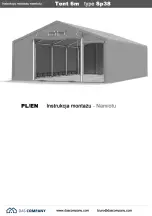
17
Tel: +49 (0) 8641 6948 - 60
•
xgloo.com
•
Attachment of the new protection strip is done in
reverse order.
When tensioning the webbing, make sure there is about
2 cm of space between the end of the roof and the
10.4 IN THE EVENT OF PRESSURE LOSS
• FIRST, be sure that all valves are closed tightly!
• If pressure loss continues, blow out the overpressure valves while pushing the spring on the
inside to remove any dust or dirt particles.
• If there is still a loss of pressure, we recommend replacing the inner bladder, as it is likely
damaged.
• To help locate the damaged area, the surface of the bladder can be sprayed with soapy
water and then the bladder inflated, so that air bubbles can be seen where the air is
escaping. Alternatively, the bladder can be filled with a small amount water so that the leak
can be identified by the forming of water drops when the bladder is inflated.
• If the damaged area can be seen from the outside and the size is less than 1 cm on the
bladder, then the bladder be sealed with the high-performance repair tape.
10.5 REPAIRING A BLADDER
The high-performance repair tape is perforation and
stretch-resistant and is specially designed for repairing
tears and holes on the bladder.
• Remove all dirt and oil from the area to be glued. Use
the included cleaning cloth for this (a).
• Cut the tape to the appropriate size and carefully
peel off the protective paper! Make sure to avoid
touching the adhesive surface as much as possible
(b).
• Press the adhesive side of the repair tape onto the
damaged area, making sure that there is sufficient
overlap. For larger tears or holes, an overlap of at
least 20 mm is recommended.
Apply firm pressure in order to maximize the
immediate adhesive strength. The final adhesive
strength will only achieved after a few hours (c).
• Let the tape stick for a few minutes before putting the
bladder to use (d).
a
c
b
d


































